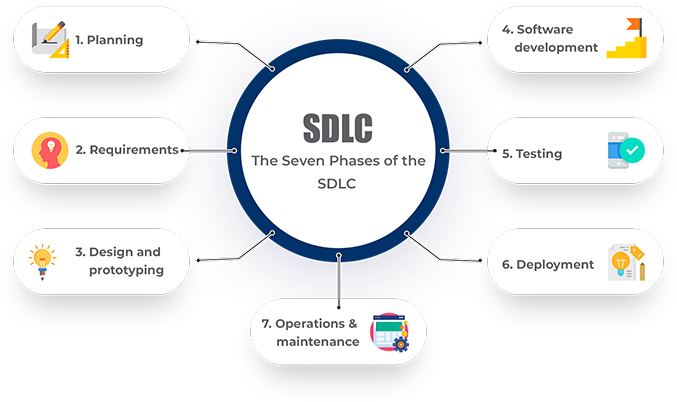Software Development
Life Cycle
The Seven Phases Of SDLC

1.Planning
The planning phase involves aspects of project and product management. This may include:
-
Resource allocation (both human and materials)
-
Capacity planning
-
Project scheduling
-
Cost estimation
-
Provisioning
The outputs of the planning phase include: project plans, schedules, cost estimations, and procurement requirements. Ideally, Project Managers and Development staff collaborate with Operations and Security teams to ensure all perspectives are represented.
2.Requirements
The planning phase involves aspects of project and product management. This may include:
The outputs of the planning phase include: project plans, schedules, cost estimations, and procurement requirements. Ideally, Project Managers and Development staff collaborate with Operations and Security teams to ensure all perspectives are represented.
3.Design and Prototyping
The planning phase involves aspects of project and product management. This may include:
The outputs of the planning phase include: project plans, schedules, cost estimations, and procurement requirements. Ideally, Project Managers and Development staff collaborate with Operations and Security teams to ensure all perspectives are represented.
4.Software Development
The planning phase involves aspects of project and product management. This may include:
The outputs of the planning phase include: project plans, schedules, cost estimations, and procurement requirements. Ideally, Project Managers and Development staff collaborate with Operations and Security teams to ensure all perspectives are represented.
5. Testing
The planning phase involves aspects of project and product management. This may include:
The outputs of the planning phase include: project plans, schedules, cost estimations, and procurement requirements. Ideally, Project Managers and Development staff collaborate with Operations and Security teams to ensure all perspectives are represented.
6. Deployment
The planning phase involves aspects of project and product management. This may include:
The outputs of the planning phase include: project plans, schedules, cost estimations, and procurement requirements. Ideally, Project Managers and Development staff collaborate with Operations and Security teams to ensure all perspectives are represented.
7. Operations and Maintenance
The planning phase involves aspects of project and product management. This may include:
The outputs of the planning phase include: project plans, schedules, cost estimations, and procurement requirements. Ideally, Project Managers and Development staff collaborate with Operations and Security teams to ensure all perspectives are represented.










